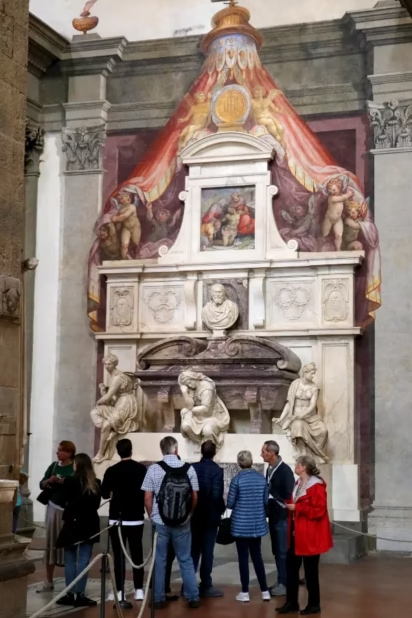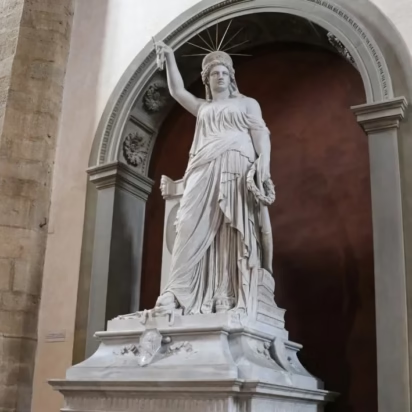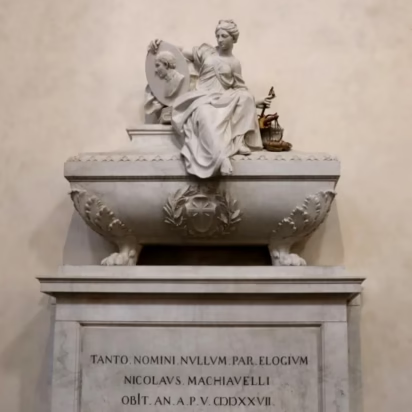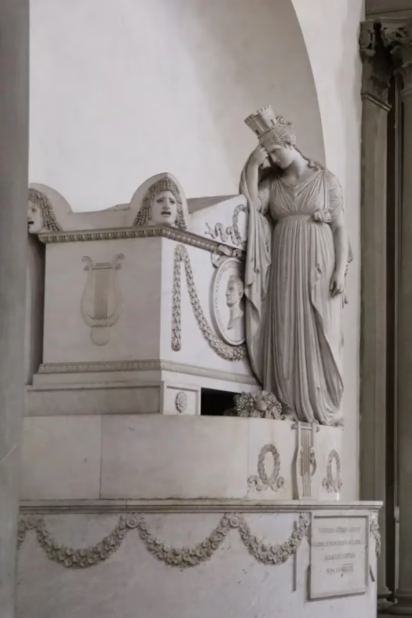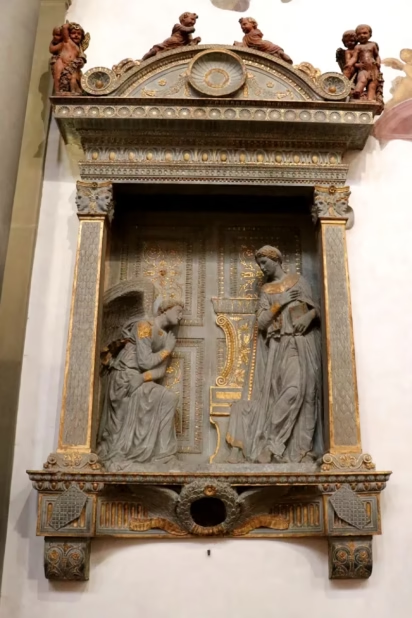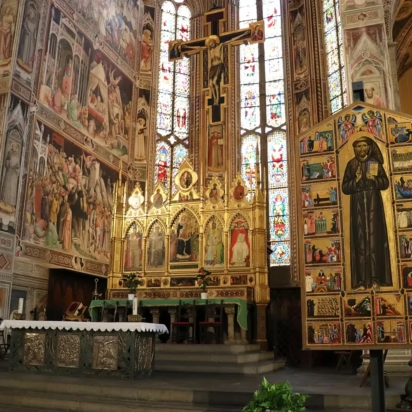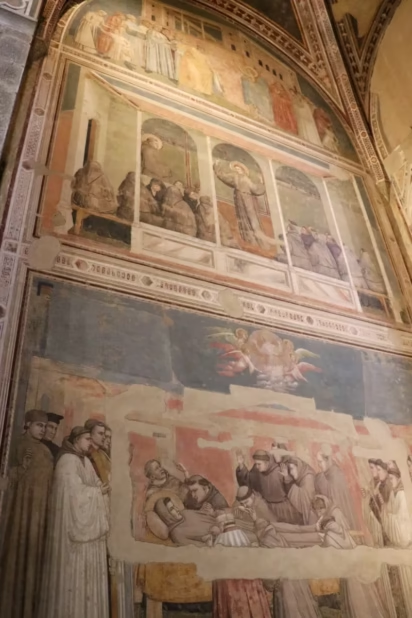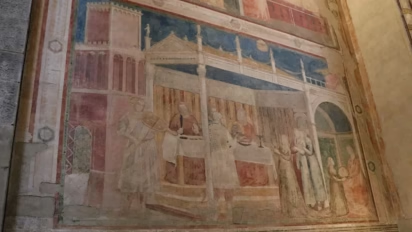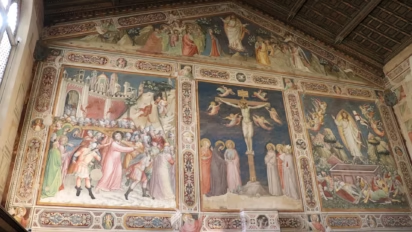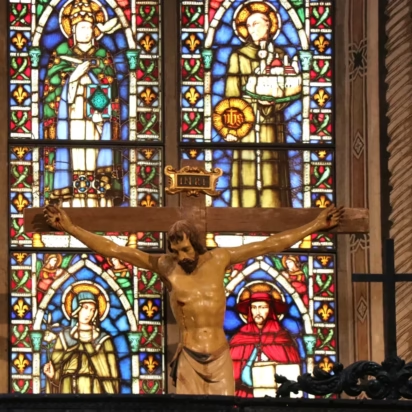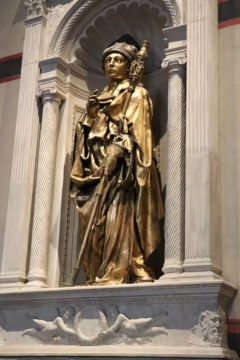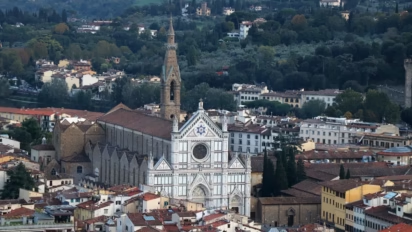The art in the Church of Santa Croce in Florence includes frescoes by Giotto and Taddeo Gaddi and the oft-visited tombs or funeral monuments for Michelangelo, Dante, Galileo, and others.

The Basilica of Santa Croce is one of the great Gothic churches of central Florence. This large Franciscan church is full of art including magnificent frescoes by Giotto and his followers such as Taddeo Gaddi and his son Agnolo Gaddi. Santa Croce is also famous as the pantheon of the Italian greats with several funeral monuments including the graves of Michelangelo, Galileo Galilei, Machiavelli, and Rossini, as well as a cenotaph for Dante. The church and adjacent small museum further have artworks by among others Donatello, Brunelleschi, Vasari, Canova, Bartolini, Ricci, Cimabue, and Henri Moore. Buy skip-the-line tickets online with time-slot reservations.
→ Top museums, churches, and sights in Florence are open mostly as normal in 2025 — see 2025: Florence Opening Hours of Top Sights, Museums, and Churches for the latest information and opening hours. The Firenzecard is again sold while the Turbopass Florence City Pass is a good alternative that includes online timeslot reservations for both the Uffizi and Accademia.
Visit the Franciscan Basilica of Santa Croce in Florence
Construction of the church of Santa Croce started in 1295 and it was mostly completed by 1385, long before the formal consecration by the pope in 1443. According to legend, St Francis of Assisi laid the foundation stone but he was in reality involved in the earlier church built nearby shortly after the Franciscan order founded a monetary outside the city walls of Florence in 1222.
The Franciscan monastery complex of Santa Croce grew into one of the largest and most influential in Florence. It became a popular place for burials for the rich and famous, as frequent prayers were guaranteed. Michelangelo picked it for his tomb and Santa Croce is in a way a national pantheon for especially Florentine notables.
The main attraction of Santa Croce to most visitors is the magnificent art inside the church. However, visitors may also visit the mostly bare cloisters, the Pazzi Chapel, and a very small museum.
Santa Croce is one of the top attractions in Florence with well over 800,000 annual visitors. The best time to visit is early morning at opening time
Basilica di Santa Croce di Firenze

The Franciscan Chiesa di Santa Croce is together with the Duomo (cathedral) and the Dominican Santa Maria Novella one of the principal large Gothic churches of Florence. The white marble facade is Neo-Gothic and was only added in 1863. This facade was funded by an English sponsor, Sir Francis Sloane. Previously, the facade was uncompleted, as was long the case with the Duomo while the Renaissance San Lorenzo remains facade-less to the present.
The Campanile is similarly a 19th-century addition. The original collapsed in a storm in 1512. Construction of its replacement was initiated but never completed.
The entrance to Santa Croce is from the left side, behind Enrico Pazzi’s large marble statue of Alighieri Dante (1865).
The basic floorplan is that of an Egyptian cross (T-shape). Although a triple-nave basilica, the openness and lack of pews towards the rear almost give the impression of a hall church. The sides of the nave are mostly decorated with Renaissance and Baroque funerary monuments while the chapels in the chancel and transept are closer to the Gothic originals.
The length of the nave is 114.45 m — medieval oneupmanship: intentionally around 15 m longer than Santa Maria Novella that was begun around 50 years earlier. The narrow nave soars up to 34.5 m — higher than for example Notre Dame in Paris
The ceiling of the nave of Santa Croce is not vaulted but rather maintains the open wood-frame structure. Franciscan churches often used this simpler ascetic architectural feature — something that is easy to overlook given the opulent art in the rest of this church.
Tombs and Funerary Monuments in Santa Croce

Santa Croce was long a popular burial place for the rich and influential of Florence. As the church of a large Franciscan monastery, frequent prayers for the buried should have speeded accent to heavens — a desire probably enhanced following the publication of Dante’s Divine Comedy.
There are nearly 300 gravestones in the floor of the church but the funerary monuments along the walls are more interesting. Santa Croce is sometimes described as the Temple of the Italian Glories, although the emphasis is on personalities with strong ties to Florence. Not all are equally famous internationally.
Michelangelo’s Grave Monument
The most famous grave in Santa Croce is that of Michelangelo Buonarroti. He died in Rome but his remains were sped to Florence to be buried in Santa Croce. According to legend, he picked this specific spot so when he rises on Judgement Day, his first sight through the open doors of the church would be Brunelleschi’s magnificent cupola of the Duomo.
Giorgio Vasari (1564-78) designed Michelangelo’s funeral monument. The Pieta sculpture Michelangelo intended for his grave remained uncompleted and never made it to Santa Croce. It is now in the Duomo Museum.
The three sculptures are allegories of Michelangelo’s top talents: Painting (by Giovan Battista Lorenzi, who also did the bust), Sculpture (by Valerio Cioli) and Architecture (attributed to Giovan Battista Lorenzi). The frescoes are by Giovan Battista Naldini.
Michelangelo’s grave is at the back of the church behind the first pillar on the right — usually the one with the largest number of visitors milling around.
Grave Monument of Galileo Galilei
The only grave monument on the left wall of Santa Croce that is of real international fame is that of Galileo Galilei (1564-1642). Although the Florentines were prepared to intern him here, Rome objected and his remains were only lain inside the church almost a century after his death. His grave, designed by Giulio Foggini (1734-37) is directly opposite that of Michelangelo and somewhat resembles the style of the much older work.
Note the remains of the 14th-century frescoes that surrounded the grave monument of Galileo — the whole nave of the church was originally covered in similar cartoon-like paintings but these were covered up when tastes changed during the Renaissance and especially the Baroque periods.
Other Funeral Monuments in Santa Croce
Near Michelangelo’s grave, but on the back wall of the church, is the monument for Italian poet and playwright Giovanni Battista Niccolini (1782-1861). His memorial statue by Pio Fedi is often simply termed the Statue of Liberty (1870-76) with the claim that it inspired Bartholdi’s much more famous one.
Next to the grave of Michelangelo is the cenotaph for Alighieri Dante (1265-1321) by Stefano Ricci (1819-30). Dante died and was buried in Ravenna while a political exile from Florence. The custodians in Ravenna refused to give up his remains and even hid his cadaver behind a false wall at times. His cenotaph in Santa Croce thus remains empty.
The grave of Italian dramatist and poet Vittorio Alfieri (1749-1803) is by the noted sculptor Antonio Canova (1804-10).
The tomb for Niccolo Machiavelli (1469-1527) was only built 260 years after his death by Innocenzo Sponazzi (1787). The inscription translates to “So great a name has no adequate praise”.
Immediately to the left of the door leading to the cloisters is the oldest and artistically one of the most accomplished of the major funeral monument in Santa Croce — the grave of the humanist historian Leonardo Bruni (1370-1444) by Bernardo Rossellino (1445-47). Next to it is the grave of the opera composer Gioachino Rossini (1792-1868) by Giuseppe Cassioli (1900-02).
To the right of the exit door is an Annunciation (1433-35) relief carved into sandstone with golden details by Donatello — one of three works by him in the Santa Croce complex.
Chapels in Sante Croce in Florence

The best art in Santa Croce in Florence is in the 16 chapels of the transept area. Many of the frescoes here are by Giotto and his pupils, especially Taddeo Gaddi, his son Agnolo Gaddi, and Masa di Banco.
Chancel — Cappella Maggiore
The chapel in the chancel (Cappella Maggiore) is a prime example of High Gothic. The frescoes are by Agnolo Gaddi (1380) and tell the story of the Legend of the True Cross that the church is named after. However, these scenes are from a popular 13th-century compilation of legends and folklore. It starts off with the archangel Michael presenting Set with a sapling to plant on the grave of Adam and ends violently with the decapitation of Cosroe, king of Persia, in Jerusalem. The scenes have remarkably little correlation to Biblical scripture.
The painted cross is by the Master of Figline while the polyptych is a recomposition: the Madonna is by Niccolo Gerini while some of the Doctors of the Church are by Giovanni del Biondo.
Giotto Frescoes in Santa Croce in Florence

The most important art in Santa Croce — and for many the main reason to visit — are the Giotto di Bondone (1267-1337) frescoes in the Bardi and Peruzzi chapels immediately to the right of the chancel. Giotto originally decorated at least four chapels in Santa Croce but only these two survived in some form today.
These late works of Giotto (1320s) cleared the way for the Renaissance. He rejected the flat Byzantine style and used realistic images. Ghirlandaio, who painted the Tornabuoni Chapel in Santa Maria Novella, was still influenced by these works 150 years later. Although much of the pictorial value of the paintings was lost, they still show the inventiveness and composition of Giotto’s hand.
During the 16th century, many of the Giotto frescoes were plastered over by Vasari, on instructions of Cosimo de Medici. This was partly due to a change in taste but also the bad condition of the frescoes at that stage. Giotto often painted on dry plaster here — possibly due to all the commissions he was trying to handle simultaneously.
The Giotto frescoes were only rediscovered in 1852 — the restorers simply added in the parts that were unrecoverable. The restoration work of 1958-59 removed the additions made a century earlier. These show the damage done but also reveal the mastery of Giotto’s work.
Giotto Frescoes in the Bardi Chapel
The more famous Giotto frescoes in the Bardi Chapel, painted around 1325, illustrate scenes from the life of St Francis of Assisi — founder of the Franciscan Order.
The main scenes here are from top to bottom:
On the left wall:
- St. Francis renounces clothes before Bishop Guido and Father Bernardone
- Apparition of Saint Francis to Saint Anthony in the Chapter of Arles
- Funeral of St. Francis with the unbelieving Jerome looking for the stigmata
On the right wall:
- Approval of the Order
- Test of fire in front of the Sultan
- Dreams of Friar Agostino and Bishop Guido of Assisi
The restoration of the frescoes in the Bardi Chapel should be completed and the chapel reopen towards the end of 2025.
Giotto Frescoes in Peruzzi Chapel
In the Peruzzi Chapel, Giotto painted scenes from the lives of John the Baptist and John the Evangelist. These were done slightly earlier than in those in the Bardi — around 1318-22.
The frescoes here are top to bottom:
Left Wall – Scenes from the life of John the Baptist
- Zachariah received the announcement from the angel
- Birth of John the Baptist and the writing of his name
- Herod’s banquet and the presentation of John’s head to Salome
Right wall – Scenes from the life of John the Evangelist
- Visions on Patmos
- Resurrection of Drusiana
- Ascension of St John
The chapel further has eight busts of the prophets on the archivolt and the symbols of the four evangelists on the pendentives of the vaults.
Baroncelli Chapel in Santa Croce

In the Baroncelli Chapel — right end of the transept — are frescoes (1332-38) by Taddeo Gaddi, a close follower of Giotto. Gaddi was clearly influenced by Giotto but his scenes from the Life of the Virgin and the Nativity are far more crowded than that of his master.
The Annunciation to the shepherds on the back wall of this chapel is generally considered the first night-lit scene painting in western art. It certainly is unique to mid-14th century art in Italy.
Also in this chapel is the large Baroncelli Polyptych (1334) attributed to Giotto, as it is signed Opus Magistri Jocti.
More Artworks in Santa Croce in Florence
The wooden wardrobes in the sacristy are from the 15th century. The large series of paintings with scenes from the life of Christ are by some of the most important painters of the Giotto school: Niccolò Gerini (Ascension, Resurrection), Taddeo Gaddi (the Crucifixion) and Spinello Aretino (Climb to Calvary).
Also in the sacristy is a painted crucifix (before 1288) by Cimabue. However, it was seriously damaged in the floods of 1966 with the face of Christ totally destroyed.
The chapels to the left of the chancel also have noteworthy art. The Bardi Chapel of Vernio has fine frescoes by Maso di Banco in the Giotto style of scenes of San Sylvester. The Capponi Chapel is dedicated to the mothers of the war dead and decorated with statues by Libero Andreotti.
In the chapel at the left end of the transept, is a painted carved wooden crucifix by Donatello (1408-10). According to Vasari, Brunelleschi described it as a peasant on the cross. Challenged by Donatello to do better, Brunelleschi, who rarely carved sculptures, produced the sublime idealistic crucifix that now hangs in the Santa Maria Novella. Donatello reportedly dropped the eggs he was carrying when he first saw the masterpiece.
The Pulci-Berardi Chapel has frescoes by Bernardo Daddi of the Martyrdom of Saint Lawrence and the Martyrdom of Saint Stephen (around 1330). The polychrome glazed terracotta is by Giovanni della Robbia – many of his works are in the Bargello.
Visit the Opera di Santa Croce in Florence

The Opera di Santa Croce now managed the former Franciscan monastery complex. In addition to the church, visitors see two large cloisters (and a third small one at the campanile) that are mostly undecorated. Before visiting the cloisters or small museum, see the Cappella Pazzi that is immediately at the exit from the church.
Capella Pazzi in Santa Croce
The Pazzi Chapel was designed by Brunelleschi as a grave chapel for the wealthy Pazzi family. It is a prime example of early Renaissance design with balanced proportions and slick grey-white overtones suitable for a grave chapel.
The basic design is inspired by Brunelleschi’s Old Sacristy in San Lorenzo but here he had to work within the confines of an existing building. The columns are thus simply style elements — the roof is carried by the existing monastery walls.
The terracottas are by Luca della Robbia while the roundels of the evangelists are sometimes attributed to Donatello. While the ceiling of the Pazzi Chapel, which is topped by an umbrella-like dome, is suitably restrained for a funeral chapel, the dome of the porch right in front is far more colorful.
Cloisters of Santa Croce
The two large cloisters of the complex are simple with clear lines as befits the ascetic principles of the Franciscans. These are mostly undecorated. In the cloisters closest to the church are two statues — God the Father (1552) by Baccio Bandinelli and Warrior with Shield (1972) by Henry Moore. Near the exit is a memorial for Florence Nightingale, who was born in and named after Florence, made by Francis William Sargent (1913).
At the far end of the second cloister is a small exhibition with photos showing the damage done by the flooding of 1966. From this point, it is basically just a short block to the banks of the Arno River. The largest national library in Italy is vulnerably positioned right here — many works were lost during floods.
Visit the Museum of Santa Croce in Florence

The small museum of Santa Croce is literally only two rooms. The more impressive is the former refectory with one wall completely covered with a large fresco with the Tree of Life and Last Supper (c. 1350) by Taddeo Gaddi — it gave the monks a lot to contemplate over while dining.
A large Last Supper by Vasari (1546) in the back of the refectory is placed on a set of cables and pulleys that allow the painting to be hoisted higher in case of flooding.
Also in the refectory is a rare gilded bronze of St Louis of Toulouse (1422-25) by Donatello. It was originally made for a niche in Orsanmichele (now used by Verrochio’s Christ and Doubting St Thomas) but spent more than three and a half centuries in the center of the unfinished facade of Santa Croce. It was one of the first large bronzes cast since antiquity.
Santa Croce Visitors Information
Santa Croce is open Monday to Saturday from 9:30 to 17:30 and Sunday from 12:30 to 17:30. It is open on most holidays, except 25 December.
The best time to visit Santa Croce is early morning. The church is one of the top sights to see in Florence and attracts well over 800,000 visitors each year. Late afternoon is also a good option but don’t leave it too late, as lights may be switched off earlier than the ticket office claims.
Entry to the complex is from the left side of the nave — just behind the statue of Dante. The exit is at the right of the facade — toilets just before the exit.
Admission is €9 or €7 for children 11 to 18. Family tickets are full price for adults but a child under 18 may accompany each paying adult for free. Buy skip-the-line tickets online with time-slot reservations for fast admission.
The Firenze Card is valid — go directly to the entrance.
Admission includes the Basilica of Santa Croce and the adjacent museum area including the Pazzi Chapel, cloisters, and two small exhibition halls.
More Articles on Florence Sights
The high season in Florence is increasingly long: Easter, May, July, August, and the Christmas holidays are especially busy. November and January to mid-March are the only quiet months, except for the February school holiday week. Plan and book time-slot reservation tickets and tours when available in advance — the Accademia and the Uffizi are again sold out weeks in advance. Top sights are quieter directly at opening time or in the late afternoon.
→→ Opening hours for top sights in 2025 — most sights have long hours but advance time-slot reservations are always sensible.
- Tips on Buying Tickets for the Uffizi Museum
- Tips on Buying Skip-the-Line Tickets for the Accademia (Michelangelo’s David)
- See Michelangelo’s David in the Galleria dell’ Accademia
- Visit the Duomo sights: Cathedral (Duomo), Baptistery (Battistero), Bell Tower (Campanile), Dome (Cupola), Museum (Museo), and Tickets + Opening Hours
- Visit the Bargello Museum of Sculpture (Donatello’s Davids)
- Visit San Marco Museum to see the frescoes and altarpieces painted by Fra Angelico.
- Visit Santa Maria Novella Church and Museum to see medieval and Renaissance Art.
- Visit Santa Croce for Giotto Frescoes and Michelangelo’s Grave
- San Lorenzo complex: Visit the Basilica for Renaissance Art, See the Laurentian Medici Library by Michelangelo, and Visit the Medici Chapels (Michelangelo Statues)
- Visit the Orsanmichele Church and Museum with sculptures.
- Save on Sightseeing in Florence with the Firenze Card (again available but not including transportation or the Duomo sights, or consider the Turbopass Florence City Pass that includes online timeslot reservations for both the Uffizi and Accademia.
- Travel to Pisa to see the Field of Miracles and the Leaning Tower of Pisa.
- Visit the magnificent Romanesque-Gothic cathedral in nearby Siena.
- Save on top Italian designer fashion at The Mall Factory Outlet Stores.
Florence Resources
- The official website of the Firenze Tourist Office is a bit cumbersome but has very useful information. Especially the pdf (alternative link) with the opening hours of all major sights. Unfortunately, it is only available for the current month but it is the second last line on opening hours — the final say is the guard at the door, NOT the ticket window!
- Get Your Guide offers tours of all major sights while Tiqets sells online tickets for many top sights in Florence.
- Book luggage storage online and explore Florence more easily on foot.
- Trainline is good for booking online train tickets in Italy and most of Europe.


